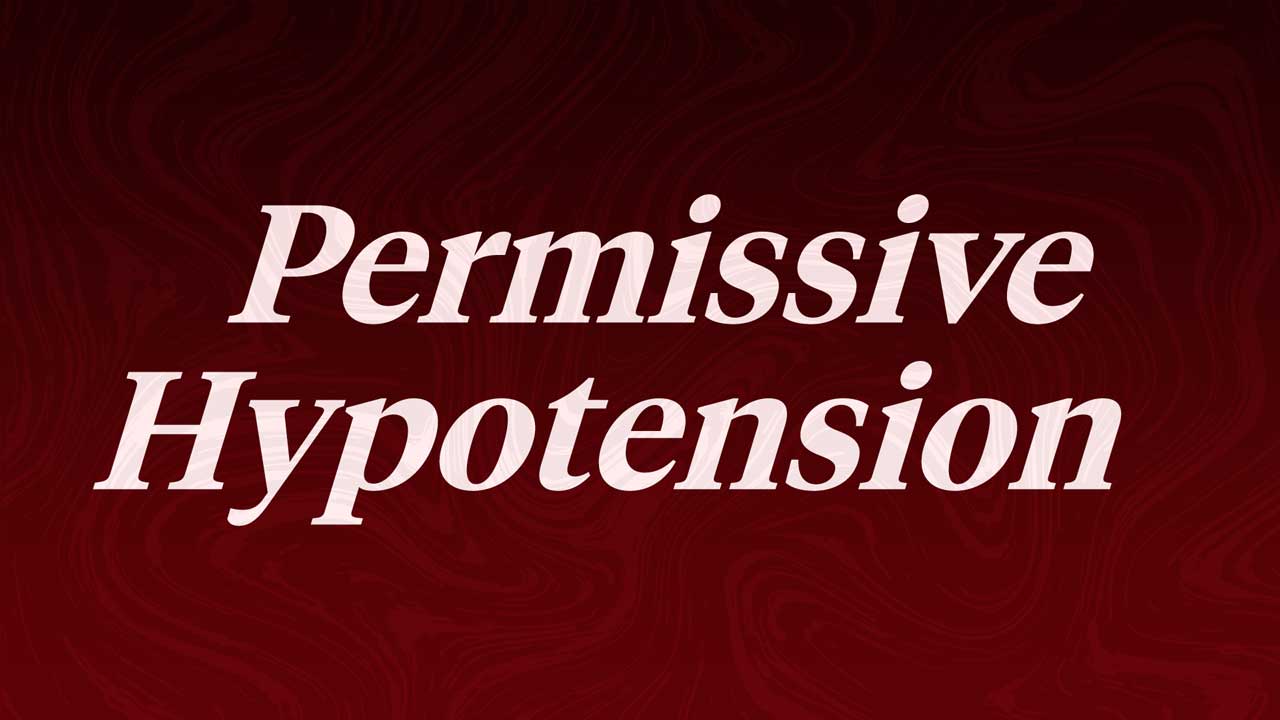Most potentially-preventable deaths following major trauma are caused by uncontrolled bleeding (Nevin & Brohi 2017).
However, researchers have found that early, high-dose fluid resuscitation may cause trauma patients experiencing severe haemorrhage to suffer adverse effects such as dilutional coagulopathy or acceleration of the haemorrhage (Kudo et al. 2017; Das et al. 2023).
Nickson (2020) describes permissive hypotension, also known as hypotensive resuscitation or low-volume resuscitation, as a controversial and uncommon method of fluid resuscitation that may result in more desirable patient outcomes.
This method is now being discussed by more and more prehospital trauma services across the world as a strategy to replace the older philosophy of higher volume fluid substitution. A systematic review by Mapstone et al. (2003) has shown a significantly higher survival rate in all animal trials when permissive hypotension strategies are applied.
The review also found that out of permissive hypotension, cyclic hyper resuscitation, and vasopressors, vasopressors had the worst patient outcomes (Mapstone et al. 2003).
While permissive hypotension can potentially prevent the adverse effects of early, high-dose fluid resuscitation, it has its own unique risks, such as tissue hypoperfusion, which must also be considered (Kudo et al. 2017). Hence, low blood pressure is not the goal but a symptom in order to minimize further clot disruption and haemodilution.
This article relates to permissive hypotension for trauma below the neck.
What is Permissive Hypotension?
Permissive hypotension is the intentional under-resuscitation of a patient, where the goal is to maintain a blood pressure that is adequate but in the lower than normal range (Moore & Moore 2018; Nevin & Brohi 2017; Kudo et al. 2017).
This is achieved by restricting the amount of fluid administered while the patient is actively bleeding, rather than aggressively resuscitating (Kudo et al. 2017; Nevin & Brohi 2017).
Permissive hypotension is considered ‘damage control resuscitation‘ that is employed only until haemorrhage control has been achieved (e.g. successful tourniquet on a catastrophically bleeding extremity) (Nickson 2020).
Why is Permissive Hypotension Used?
Aggressively resuscitating trauma patients was once considered the standard method of restoring circulating volume and maintaining organ perfusion (Ramesh et al. 2019).
However, during active bleeding, this strategy may be unable to resuscitate the patient, restore perfusion and clear oxygen debt (Nevin & Brohi 2017) due to the increased haemodilution of the blood as well as the associated reduction of the clotting factors. A combination of blood transfusion and fresh frozen plasma would be the gold standard; however, this is highly difficult in a prehospital environment.
Additionally, aggressive resuscitation during active bleeding may lead to serious adverse effects, including:
- Oedema
- Compartment syndrome
- Acute lung injury
- Exacerbation of anaemia
- Thrombocytopaenia
- Organ failure
- Hypothermia
- Coagulopathy
- Exacerbation of bleeding due to clot disruption
- Death
(NBA 2011; Moore & Moore 2018; Kudo et al. 2017; Nevin & Brohi 2017)
While aggressive resuscitation increases blood pressure, potentially causing disruption to the clot and consequently, further blood loss (Nickson 2020), permissive hypotension aims to keep blood pressure at a low enough (but adequate) level to optimize organ perfusion and coagulation until hemostasis is achieved (Nevin & Brohi 2017).
Note that low blood pressure is not the goal; rather, it is a tool used as a compromise until the patient is able to undergo a surgical intervention to stop the otherwise uncontrollable bleeding (Nickson 2020).
Permissive hypotension is a method of rapid stabilization suitable for prehospital settings and should not be used once the bleeding has been controlled in the operating room, where the gold standard is the volume substitution with blood products (Das et al. 2023).

When Should Permissive Hypotension be Used?
Generally, permissive hypotension is indicated for hemodynamically unstable patients who are experiencing uncontrolled bleeding (Das et al. 2023).
It is not considered an appropriate strategy for traumatic brain injury or spinal injury, as tissue hypoperfusion in the central nervous system may cause secondary injury (Kudo et al. 2017).
Permissive hypotension should be considered on a case-by-case basis, and patients should be assessed for prior history that could place them at risk (Das et al. 2023).
Those who may be appropriate candidates include:
- Patients who do not have chronic hypertension and who need higher blood pressures in order to maintain minimum tissue perfusion
- Patients who do not have long-term cardiovascular abnormalities
- Patients who do not have endocrine abnormalities
(Das et al. 2023)
Benefits of Permissive Hypotension
Permissive hypotension is associated with:
- Decreased blood loss
- Decreased risk of:
- Intra-abdominal hypertension
- Acidaemia
- Haemodilution
- Thrombocytopaenia
- Coagulopathy
- Apoptotic cell death
- Tissue injury
- Sepsis
- Mortality
- Lower volumes of crystalloid administration needed
- Lower blood product utilization
- Improved organ perfusion and survival (mainly proven in animal trials)
- Faster recovery
- Decreased postoperative recovery time
(Ramesh et al. 2019; Das et al. 2023)
Complications of Permissive Hypotension
- Non-haemorrhagic causes of hypotension such as tension pneumothorax and pericardial tamponade may potentially be overlooked
- The level of blood pressure that needs to be maintained will depend on the individual
- The safe low threshold for systolic blood pressure is unknown
- The maximum amount of time that permissive hypotension can safely be performed is unknown, which might play an important role in longer transport settings to reach a trauma hospital
- Tissue hypoperfusion
- Depending on the location, patients may be unable to quickly and easily access a trauma centre.
(Nickson 2020; NBA 2011; Das et al. 2023)
Performing Permissive Hypotension

When confronted with an acutely bleeding trauma patient, the priorities are to control the haemorrhage; ensure organ perfusion whilst preventing coagulopathy, acidosis, and hypothermia from developing; and quickly transport the patient to a facility where definitive haemorrhage control can be achieved (Ambulance Victoria 2019).
The patient should be handled carefully. Limit movement, avoid log rolls and take care during transportation in order to avoid disrupting early clot formation (Nottingham University Hospitals 2019).
- Assess whether the patient is experiencing hypovolaemia due to a haemorrhagic cause (e.g. gastrointestinal bleed, abdominal aortic aneurysm or trauma below the neck). Proceed only if this is the case.
- Prioritise taking control of the haemorrhage over all other interventions.
- Rule out any other potential causes of hypovolaemia such as tension pneumothorax, significant pain and environmental exposure.
If the patient’s systolic blood pressure (SBP) is less than 70 mmHg:
- Prioritize immediate transport
- Administer normal saline 250 mL intravenously.
- Repeat this as required, but do not exceed 2000 mL in total.
- Titrate to a SBP of 70 mmHg or more.
- If there is an inadequate response, consult for further management.
- Consider the availability of blood products such as AAV.
(Ambulance Victoria 2019)
If the patient’s systolic blood pressure (SBP) is 70 mmHg or more:
- The patient can tolerate hypotension for up to two hours without fluid replacement.
- Prepare for deterioration.
- Consult with the clinician at the receiving hospital for management if:
- There is a long prehospital time
- There is a prolonged extrication
- The patient is frail or an older adult.
(Ambulance Victoria 2019)
Other Considerations
- It may be difficult to determine the blood pressure of critically ill patients. An absent radial pulse and decreased alertness may suggest that blood pressure is below 70 mmHg.
- If the patient’s blood pressure is 70 mmHg or more (or there is a radial pulse present) but the patient is not alert, consider alternative causes of their altered conscious state (e.g. traumatic brain injury, hypoglycaemia, dementia).
- If there are signs of unacceptably poor perfusion or deterioration, or an adequate blood pressure can not be achieved, consult other options. These may include further fluid, the use of pressors or the delivery of blood products.
- The preferred resuscitation fluid is blood products. These should be used instead of normal saline if possible.
- Do not delay transport for IV therapy.
(Ambulance Victoria 2019)
Note: This article is intended as a refresher and should not replace best-practice care. Always refer to your organization's policy on resuscitation and permissive hypotension.
Test Your Knowledge
Question 1 of 2
When would permissive hypotension be considered?
Topics
References
- Ambulance Victoria 2019, Clinical Practice Guidelines: ALS and MICA Paramedics, Victoria State Government, viewed 17 October 2023, https://www.ambulance.vic.gov.au/wp-content/uploads/2020/09/avcpg_mica_als.pdf
- Das, JM, Anosike, K & Waseem, M 2023, ‘Permissive Hypotension’, StatPearls, viewed 17 October 2023, https://www.ncbi.nlm.nih.gov/books/NBK558915/
- Kudo, D, Yoshida, Y & Kushimoto, S 2017, ‘Permissive Hypotension/Hypotensive Resuscitation and Restricted/Controlled Resuscitation in Patients with Severe Trauma’, Journal of Intensive Care, vol. 5 no. 11, viewed 17 October 2023, https://jintensivecare.biomedcentral.com/articles/10.1186/s40560-016-0202-z
- Mapstone, J, Roberts, I & Evans, P 2003, ‘Fluid Resuscitation Strategies: A Systematic Review of Animal Trials’, Journal of Trauma, vol. 55 no. 3, viewed 17 October 2023, https://journals.lww.com/jtrauma/Abstract/2003/09000/Fluid_Resuscitation_Strategies__A_Systematic.32.aspx
- Moore, HB & Moore, EE 2018, ‘Posttraumatic Hemorrhagic Shock’, in Alden HH & Ernest EM (eds.), Abernathy's Surgical Secrets, 7th edn, viewed 17 October 2023, https://www.sciencedirect.com/topics/medicine-and-dentistry/permissive-hypotension
- National Blood Authority 2011, ‘3.4 Permissive Hypotension and Minimal Volume Resuscitation’, Patient Blood Management Guidelines, viewed 17 October 2023, https://www.blood.gov.au/system/files/documents/pbm-module-1.pdf
- Nevin, D G & Brohi, K 2017, ‘Permissive Hypotension for Active Haemorrhage in Trauma’, Anaesthesia, vol. 72 no. 12, viewed 17 October 2023, https://associationofanaesthetists-publications.onlinelibrary.wiley.com/doi/full/10.1111/anae.14034
- Nickson, C 2020, Permissive Hypotension, Life in the Fast Lane, viewed 17 October 2023, https://litfl.com/permissive-hypotension/
- Nottingham University Hospitals 2019, Permissive Hypotension - TOTM, online video, 11 November, viewed 17 October 2023, https://www.youtube.com/watch?v=GAgVkB6ryb0&feature=emb_title
- Ramesh, GH, Uma, JC & Farhath, S 2019, ‘Fluid Resuscitation in Trauma: What are the Best Strategies and Fluids?’, International Journal of Emergency Medicine, vol. 12 no 38, viewed 17 October 2023, https://intjem.biomedcentral.com/articles/10.1186/s12245-019-0253-8
 New
New 
